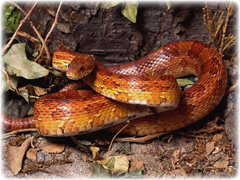Corn Snake
Introduction
Corn snakes (Elaphe guttata) are colubrids. They are primarily terrestrial but can climb into trees and low shrubs. The average life span is 10 years. Corn snakes are among the easiest of pet snakes to keep.
Morphology
Hatchlings are 20-35 cms in length while adults are generally 75-150 cms. Females are smaller than males. Corn snakes have a background colour of orange. On the dorsum they have a series of reddish blotches often edged in black while ventrally they may have white with black checking. Some of the most common colour variants are amelanistics (lacking black pigment), anerythristics (lacking red pigment), snows (both amelanistic and anerythristic), ghosts (anerythristic and hypomelanistic), stripes (having dorsal blotches replaced by red stripes and no black checking on ventrum) and motleys (having a complex mix of stripes and blotches on the dorsum and no black checking on the ventrum).
Free-Living
- Distribution– Corn snakes are found in southeastern United States. They are most active at night or in the hours of dawn and dusk.
- Diet – Corn snakes are constrictors and start feeding on small invertebrates, small lizards and frogs. Adults will feed on rodents, lizards and birds.
Captivity
- Caging - Corn snakes do not require elaborate caging. Baby corn snakes can be kept in a 5-10 gallon tank while adults require a 15 or 20 gallon aquarium.
- Temperature – A temperature range between 25-30°C is adequate.
- Diet – Hatchlings will take pinkie mice every 3-4 days and as they grow the size of the prey should be increased. An adult corn snake can eat a small rat or medium to large mouse every 7-10 days.
- Reproduction – Corn snakes are oviparous and become sexually mature at approximately two years of age. Prior to reproduction they require a period of cooling. Egg-laying occurs about 30-40 days after mating. Incubated in moist vermiculite or peat and sand at 27-28°C, the eggs should pip in 56-62 days. Hatchlings typically emerge from their eggs 24 hours after pipping.
- Veterinary considerations – Corn snakes are prone to dystocia.
| Corn Snake Learning Resources | |
|---|---|
 Search for recent publications via CAB Abstract (CABI log in required) |
Corn Snakes (Elaphe guttata) publications |
| This article has been peer reviewed but is awaiting expert review. If you would like to help with this, please see more information about expert reviewing. |
Error in widget FBRecommend: unable to write file /var/www/wikivet.net/extensions/Widgets/compiled_templates/wrt695c86f16960c4_74193102 Error in widget google+: unable to write file /var/www/wikivet.net/extensions/Widgets/compiled_templates/wrt695c86f16fc0a3_29478954 Error in widget TwitterTweet: unable to write file /var/www/wikivet.net/extensions/Widgets/compiled_templates/wrt695c86f179ef78_49886889
|
| WikiVet® Introduction - Help WikiVet - Report a Problem |
